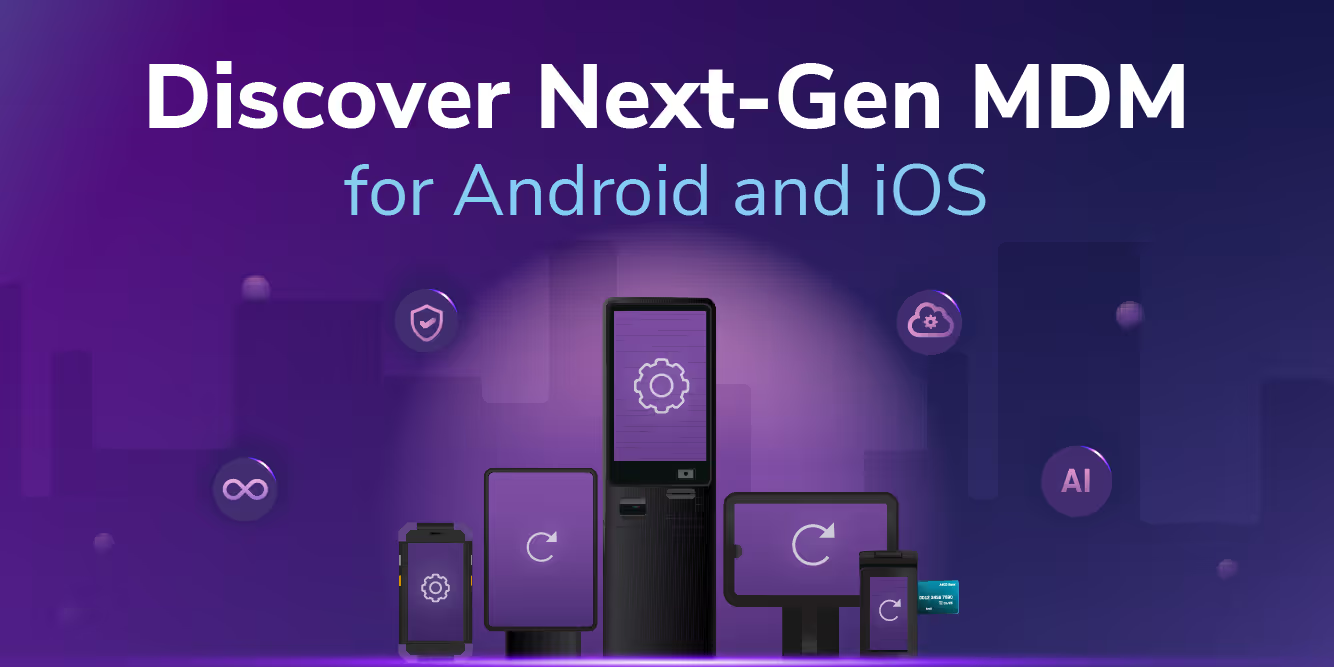A minor UI glitch on a self-checkout kiosk stops a transaction from completing after a recent update. The call comes in: It’s affecting every POS device in the store. It’s the stuff of nightmares for retail, restaurant, and hospitality IT leaders, immediately setting off a scramble to identify affected systems and initiate a rollback plan — if one exists.
Android emerged as the POS platform of choice for enterprises in recent years, offering a wireless-first, highly secure, lightweight, and extensible architecture. Yet relatively few IT operators are taking advantage of those capabilities to transform the way they manage devices.
The result: Root cause analysis from that minor glitch takes a back seat to triaging the damage; teams are taken off other projects to walk floor staff through manual remediation over the phone, on-site support is activated, and new deployments grind to a halt. The speed with which such incidents spread and the severity of escalation they inevitably demand incur very concrete costs for businesses. This includes lost revenue, non-recurring support and engineering, and destruction of customer loyalty, and stifled innovation.
And it’s past time for a proactive device management revolution, one powered by the era of advanced mobile device management (MDM). Advanced fleets require advanced tools that automate tasks and enable proactive monitoring and remediation, not just a “rip and replace” of your fleet. This change is as much technical as it is cultural, and it demands real strategy to implement.
How Do You Proactively Monitor and Fix Android POS Devices?
Building a resilient, proactive device management strategy for your POS fleet isn’t going to happen overnight — there’s no “lightswitch” solution that can work across every organization. But taken piece by piece, there are clear markers to align to on the path to a more sustainable, cost-effective culture of device management.
The answer lies in both equipping your team with the right tools and rethinking how they operate to build agile, automated, and scalable device fleets. The first step is simple but essential — establish a clear baseline for fleet health so every action that follows is built on a strong, reliable foundation:
Establish a baseline for fleet health
You need to establish the parameters that define what “all systems normal” looks like at a device fleet level. There are a huge number of factors to consider here, including:
- Which devices need to be connected to power? Which ones need a certain charge level at the start of business?
- Which devices need to be connected to Bluetooth peripherals to operate?
- Which mobile devices need to remain in a geofenced area?
- Which devices always require internet connectivity?
- What application should be running on each device, and what is the minimum version?
- What minimum OS and security patch version should your devices be running?
These are just a few examples of how you might define fleet health. Every retailer or restaurant operator is going to have different conditions they’ll need to consider as part of the holistic “fleet health” measure. From there, you can start defining which conditions demand your team’s attention.
Automate alerts
Once you’ve defined the variables that paint your overall “fleet health” picture, you need to determine the various states that should trigger an alert on your MDM frontend. Some examples of when you may want to set an alert:
- Device is below 50% battery more than three hours before close
- Device leaves a geofence area (tigger a device alarm and alert)
- Device does not check in for 2 hours (i.e., no internet connectivity)
- A device fails to connect to Bluetooth peripheral more than 3 times
- A device is not running OS, app, or a preset security patch version, and updating fails after 2 attempts
With an advanced MDM, defining such custom alerts can be straightforward. You can also decide how alert escalation is handled based on the particular alert. For example, a device failing to update to the latest app version may not warrant generating a ticket, email, or text message to support staff — it can be caught in aggregate on the device management UI. But a device that triggers a geofence alarm, all channels should be notified ASAP to mitigate potential data theft.
Ensuring that alerts don’t just become white noise is as crucial as creating them in the first place, and gets back to our cultural shift touchstone: If you don’t have these human conversations about how to use tools, all the tools in the world can’t save you.
Automate compliance & drift management
With the right tools, it’s entirely possible to ensure that your devices are running the right content, apps, and configuration settings they need to — and for them to automatically apply the correct content and settings if they aren’t. Potentially, within minutes of the drift being flagged.
An advanced Android MDM solution, allows you to do this relatively seamlessly with the help of desired state management features. If you’ve defined a device’s desired state (configuration, content, software version), it really should be a matter of “set it and forget it.” If a device fails to update the first time, the next time it checks in, your device management solution will attempt to push that deployment — retrying until it works. If it never works, you should get alerted. And that’s really what proactive device management looks like — your tools should know when to flag a human, but do what they can to solve the situation with automation before you need to get involved.
Build preemptive remediation workflows
When you’re at the point that you’ve decided which state your devices need to be in, automated drift management from those states, and defined when they’ll escalate if they’re not meeting the conditions you’ve set, you’re well on the way to true device management by exception. The next step is self-healing with preemptive remediation.
Building workflows specific to your devices and the way they’re used takes time and experience, there’s no way around that. You’re the expert, and you understand the scenarios, bugs, and fixes that occur in the field. Many of our customers in retail or restaurants have built preemptive remediation workflows around things like Bluetooth peripherals, writing scripts that trigger when peripherals won’t connect.
For example, if a Bluetooth peripheral is disconnected, the script (running on the device directly!) triggers and attempts to reconnect. If reconnection fails, the script tells the OS to cycle the Bluetooth setting on and off, then try connecting again (a common “fix” for Bluetooth connectivity issues). What used to be an issue employees would need to manage every day becomes handled invisibly — thanks to preemptive remediation.
You can imagine similar workflows built around Wi-Fi connectivity, restarting applications when content fails to load, or even rebooting the device after multiple app crashes occur. These preemptive remediations through are game-changers, especially when considered in the aggregate number of support calls and tickets that never have to be raised in the first place. Your in-store staff can focus on customers, and your IT and ops staff can focus on enabling innovation and new deployments. Win-win.
Achieve true remote support
Of course, some issues will always make it through — and deservedly so. What matters in a proactive monitoring environment is that you’ve done everything possible to flag that the issues that do make it to you are the ones that require human intervention. But that doesn’t mean every such issue gets escalated the same way, those that can be diagnosed and remediated remotely should be.
If you’re using Android POS as part of your device environment, you have a lot of remote accessibility at your fingertips (provided you’re using a modern MDM). Fully remote control of devices is totally achievable with Android, allowing support teams to diagnose, test, and validate fixes without ever going on-site (or taking an employee off the floor to control the device in person). Remote debugging should also be possible with features like remote ADB over secure tunnel, meaning that even complex issues can be diagnosed off-site.
With all of the above pieces in place, you’ll have a robust, automated, and self-healing Android POS device monitoring and remediation strategy.
How Proactive Device Management Yields Positive Business Outcomes
Optimizing cost and staff resourcing are huge wins on their own in retail and QSR IT, no doubt. But what we think is crucial to drive home to all stakeholders in the business is that a proactive device management strategy actually enables growth and innovation for consumer-facing industries.
Consider the culture of automation and self-remediation you’ll build in your IT and ops orgs, and how this will reframe the way those teams deliver. Instead of being focused on putting out fires, those teams will be focused on how to optimize the deployment of hardware and software — going faster, more frequently, and with far fewer manual steps.
They’ll also be more agile, available, and confident in the systems they’ve designed. With enhanced capacity and scalability, they can spend more time on enabling product and developer teams who want to push the envelope on innovation. Teams can build automations and workflows for lab testing — accelerating time-to-market for strategic initiatives by providing the critical incubation infrastructure for new products and experiences.
It’s all possible with the right people, processes, and tools. Modern, advanced MDM is one piece of that puzzle, but it’s what you do with that piece that makes everything else fall into place.
FAQ
Keep Exploring








%20(1).png)








